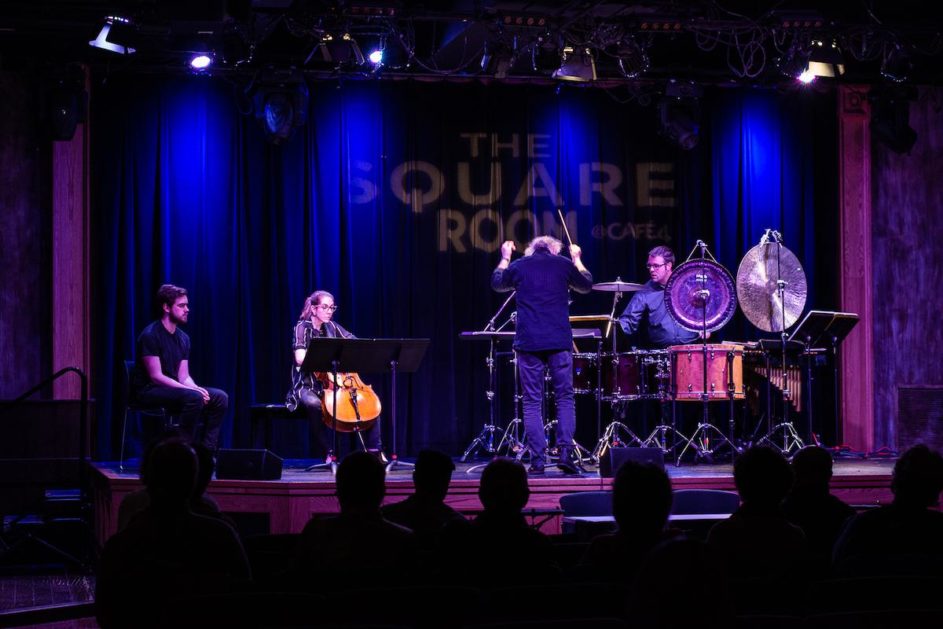Before hearing a piece for solo cello called “Nähte” (“Stitched”), written just last year by Trevor Bača, one can think of all kinds of things – if the micro-focus is tight enough – to imagine what a needle, or other sewing instrument, might sound like passing through a variety of materials.

Cellist Ashley Walters performing “Nähte” (Photo provided)
Saturday night at the Square Room downtown, in the second of Nief-Norf’s Knoxville Concert Series, this one called “Fresh Ink” because of the brand-new music on the program, cellist Ashley Walters used her bow to scratch, slide up and down, and push her way across the cello strings to generate a surprising range of sound shapes that had a more musical sense about them than one might expect.
If one thinks of music as systematic, organized explorations of the sound world, in much the same way the pioneer in this area of music, John Cage, imagined music to be, Nief-Norf is following that vision. Nief-Norf’s special world is the avant-garde of the avant-garde, not even remotely close to musical nihilism.
One of Cage’s most famous compositions doesn’t involve actually making any sound at all, but learning to listen to the sounds that surround us. His “4’33” (“4 minutes 33 seconds”) involves a musician (say, a pianist) sitting at the instrument, doing exactly nothing for the span of time. I’ve “heard” this piece performed several times. It is amazing what one hears when listening carefully.
But now, Cage’s influence has become so much a part of the mainstream that there is room for new music that explores the new edges, precisely Nief-Norf’s world. That’s what Walters’ piece seemed to be about: extending what the beginning of the sound of a bow touching the strings is instead of quickly moving past it to the strings vibrating in an orthodox pitch. Or what the final decay of sound is like, without the initial attack of setting the strings in motion.
Many of the sounds were like the sound of bumblebees coming in for a landing on a flower, then taking off again. There were the abrupt sound endings of a bee’s crash landing, too. At moments, the bow skipped across the strings. At others, it simply whined and cried. There were also moments very close to speech sounds – especially when Walters’ bow moved in circular patterns – and a little laughing, too.

Cellist Ashley Walters and saxophonist Allison Adams performing “Duo Sonata for Alto Saxophone and Violoncello” (Photo provided)
The second work on the program, Sofia Gubaidulina’s “Duo Sonata for Alto Saxophone and Violoncello,” featured Walters again, this time playing with the extraordinarily gifted saxophonist Allison Adams.
The sonata was originally written for two bassoons, but the combined sonorities of the saxophone and the cello were often celestially beautiful. There was more of what one expects in conventional music, without any extended actual melody lines. There were beautiful trills that passed back and forth and rising and falling lines that spiraled upward.
At moments during cello quavers (holding a tone with the bow moving rapidly back and forth) Adams flutter-tongued beautiful tones on the saxophone that were very close to humming.
At moments when Adams played exquisite overtones on her sax, Walters made sounds like a heavy steel door squeaking open.

Abby Fisher and Alex Richard performing “Rot Blau I” (Photo by Harold Duckett)
Jessie Marino’s 2009 “Rot Blau I” (“Red Blue I”) was a work of an entirely different order. It featured Abby Fisher and Alex Richard, wearing red and blue wigs, with matching red or blue gloves with white palms, sitting at a table, making gestures somewhere between a hand drummer and a pantomime artist. Essentially a descendant of Steve Reich’s landmark piece “Clapping,” in which two musicians hand-clapped in two different rhythm patterns, “Rot Blau I” featured the gloved hands of Fisher and Richard tapping and slapping the table, along with making shuffling sounds by opening and clenching their two hands in the middle of the pair. Parts of the piece were very funny, especially when the pair put red and blue lights in their mouths and made animal sounds – kind of clowning as music.
The program ended with the world premiere of composer Lewis Nielson’s “Bogen und Kehre,” written over the years 2017 and 2018, a work for traditional percussion instruments and cello. Nief-Norf founder Andy Bliss joined cellist Walters. Nielson was on hand to conduct because the extensive range of percussion instruments required only one percussionist but two music stands, which meant keeping the piece together without a conductor would have been very difficult since the two musicians watching each, plus reading the music, would have been next to impossible.
Translated as “bend and turn,” “Bogen und Kehre” is a term used in architecture to refer to the building of arches, in which a shape bends and returns on both ends.
The percussion instruments included a range of drums, cymbals and a xylophone that was played with mallets and by bowing on the edge of the key to produce eerie, ghostly sounds, while the cymbals and drums were played by both mallets and brushes.
The scope of sounds on the cello included snaps, zings and tapping on the cello strings, including some gorgeous moments with Bliss bowing the xylophone while Walters played ethereally light sounds on the cello strings.
There were also moments of luminous double-stopping sounds on the cello that sounded like voices warming up, while glowing chords were played by bowing the xylophone.
Considered altogether, it was a musical evening that was unexpected, haunting and surprisingly charming. Not surprisingly, Nief-Norf has become a regular fixture at Big Ears, where audiences come specifically to hear this sound world.
More about Nief-Norf and their schedule of performances can be found here.

